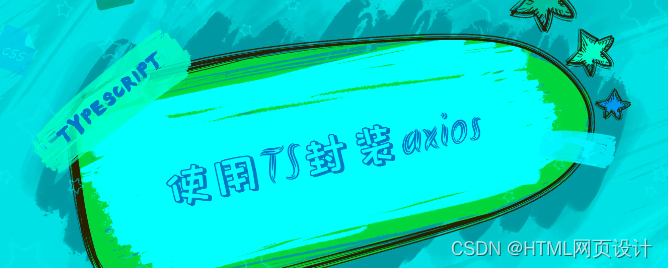本文主要是介绍在项目中用ts封装axios,一次封装整个团队受益,希望对大家解决编程问题提供一定的参考价值,需要的开发者们随着小编来一起学习吧!

写在前面
虽然说Fetch API已经使用率已经非常的高了,但是在一些老的浏览器还是不支持的,而且axios仍然每周都保持2000多万的下载量,这就说明了axios仍然存在不可撼动的地位,接下来我们就一步一步的去封装,实现一个灵活、可复用的一个请求请发。
这篇文章封装的axios已经满足如下功能:
- 无处不在的代码提示;
- 灵活的拦截器;
- 可以创建多个实例,灵活根据项目进行调整;
- 每个实例,或者说每个接口都可以灵活配置请求头、超时时间等;
- 取消请求(可以根据url取消单个请求也可以取消全部请求)。
基础封装
首先我们实现一个最基本的版本,实例代码如下:
// index.ts
import axios from 'axios'
import type { AxiosInstance, AxiosRequestConfig } from 'axios'
class Request {
// axios 实例
instance: AxiosInstance
constructor(config: AxiosRequestConfig) {
this.instance = axios.create(config)
}
request(config: AxiosRequestConfig) {
return this.instance.request(config)
}
}
export default Request
复制代码
这里将其封装为一个类,而不是一个函数的原因是因为类可以创建多个实例,适用范围更广,封装性更强一些。
拦截器封装
首先我们封装一下拦截器,这个拦截器分为三种:
- 类拦截器
- 实例拦截器
- 接口拦截器
接下来我们就分别实现这三个拦截器。
类拦截器
类拦截器比较容易实现,只需要在类中对axios.create()创建的实例调用interceptors下的两个拦截器即可,实例代码如下:
// index.ts
constructor(config: AxiosRequestConfig) {this.instance = axios.create(config)
this.instance.interceptors.request.use(
(res: AxiosRequestConfig) => {
console.log(‘全局请求拦截器’)
return res
},
(err: any) => err,
)
this.instance.interceptors.response.use(
// 因为我们接口的数据都在res.data下,所以我们直接返回res.data
(res: AxiosResponse) => {
console.log(‘全局响应拦截器’)
return res.data
},
(err: any) => err,
)
}
复制代码
我们在这里对响应拦截器做了一个简单的处理,就是将请求结果中的.data进行返回,因为我们对接口请求的数据主要是存在在.data中,跟data同级的属性我们基本是不需要的。
实例拦截器
实例拦截器是为了保证封装的灵活性,因为每一个实例中的拦截后处理的操作可能是不一样的,所以在定义实例时,允许我们传入拦截器。
首先我们定义一下interface,方便类型提示,代码如下:
// types.ts
import type { AxiosRequestConfig, AxiosResponse } from 'axios'
export interface RequestInterceptors {// 请求拦截requestInterceptors?: (config: AxiosRequestConfig) => AxiosRequestConfigrequestInterceptorsCatch?: (err: any) => any// 响应拦截responseInterceptors?: (config: AxiosResponse) => AxiosResponseresponseInterceptorsCatch?: (err: any) => any
}
// 自定义传入的参数
export interface RequestConfig extends AxiosRequestConfig {interceptors?: RequestInterceptors
}
复制代码定义好基础的拦截器后,我们需要改造我们传入的参数的类型,因为axios提供的AxiosRequestConfig是不允许我们传入拦截器的,所以说我们自定义了RequestConfig,让其继承与AxiosRequestConfig 。
剩余部分的代码也比较简单,如下所示:
// index.ts
import axios, { AxiosResponse } from 'axios'
import type { AxiosInstance, AxiosRequestConfig } from 'axios'
import type { RequestConfig, RequestInterceptors } from './types'
class Request {
// axios 实例
instance: AxiosInstance
// 拦截器对象
interceptorsObj?: RequestInterceptors
constructor(config: RequestConfig) {
this.instance = axios.create(config)
this.interceptorsObj = config.interceptors
<span class="hljs-variable language_">this</span>.<span class="hljs-property">instance</span>.<span class="hljs-property">interceptors</span>.<span class="hljs-property">request</span>.<span class="hljs-title function_">use</span>(<span class="hljs-function">(<span class="hljs-params">res: AxiosRequestConfig</span>) =></span> {<span class="hljs-variable language_">console</span>.<span class="hljs-title function_">log</span>(<span class="hljs-string">'全局请求拦截器'</span>)<span class="hljs-keyword">return</span> res},<span class="hljs-function">(<span class="hljs-params">err: <span class="hljs-built_in">any</span></span>) =></span> err,
)<span class="hljs-comment">// 使用实例拦截器</span>
<span class="hljs-variable language_">this</span>.<span class="hljs-property">instance</span>.<span class="hljs-property">interceptors</span>.<span class="hljs-property">request</span>.<span class="hljs-title function_">use</span>(<span class="hljs-variable language_">this</span>.<span class="hljs-property">interceptorsObj</span>?.<span class="hljs-property">requestInterceptors</span>,<span class="hljs-variable language_">this</span>.<span class="hljs-property">interceptorsObj</span>?.<span class="hljs-property">requestInterceptorsCatch</span>,
)
<span class="hljs-variable language_">this</span>.<span class="hljs-property">instance</span>.<span class="hljs-property">interceptors</span>.<span class="hljs-property">response</span>.<span class="hljs-title function_">use</span>(<span class="hljs-variable language_">this</span>.<span class="hljs-property">interceptorsObj</span>?.<span class="hljs-property">responseInterceptors</span>,<span class="hljs-variable language_">this</span>.<span class="hljs-property">interceptorsObj</span>?.<span class="hljs-property">responseInterceptorsCatch</span>,
)
<span class="hljs-comment">// 全局响应拦截器保证最后执行</span>
<span class="hljs-variable language_">this</span>.<span class="hljs-property">instance</span>.<span class="hljs-property">interceptors</span>.<span class="hljs-property">response</span>.<span class="hljs-title function_">use</span>(<span class="hljs-comment">// 因为我们接口的数据都在res.data下,所以我们直接返回res.data</span><span class="hljs-function">(<span class="hljs-params">res: AxiosResponse</span>) =></span> {<span class="hljs-variable language_">console</span>.<span class="hljs-title function_">log</span>(<span class="hljs-string">'全局响应拦截器'</span>)<span class="hljs-keyword">return</span> res.<span class="hljs-property">data</span>},<span class="hljs-function">(<span class="hljs-params">err: <span class="hljs-built_in">any</span></span>) =></span> err,
)
}
}
复制代码
我们的拦截器的执行顺序为实例请求→类请求→实例响应→类响应;这样我们就可以在实例拦截上做出一些不同的拦截,
接口拦截
现在我们对单一接口进行拦截操作,首先我们将AxiosRequestConfig类型修改为RequestConfig允许传递拦截器;然后我们在类拦截器中将接口请求的数据进行了返回,也就是说在request()方法中得到的类型就不是AxiosResponse类型了。
我们查看axios的index.d.ts中,对request()方法的类型定义如下:
// type.ts
request<T = any, R = AxiosResponse<T>, D = any>(config: AxiosRequestConfig<D>): Promise<R>;
复制代码也就是说它允许我们传递类型,从而改变request()方法的返回值类型,我们的代码如下:
// index.ts
request<T>(config: RequestConfig): Promise<T> {return new Promise((resolve, reject) => {// 如果我们为单个请求设置拦截器,这里使用单个请求的拦截器if (config.interceptors?.requestInterceptors) {config = config.interceptors.requestInterceptors(config)}this.instance.request<any, T>(config).then(res => {// 如果我们为单个响应设置拦截器,这里使用单个响应的拦截器if (config.interceptors?.responseInterceptors) {res = config.interceptors.responseInterceptors<T>(res)}
<span class="hljs-title function_">resolve</span>(res)}).<span class="hljs-title function_">catch</span>(<span class="hljs-function">(<span class="hljs-params">err: <span class="hljs-built_in">any</span></span>) =></span> {<span class="hljs-title function_">reject</span>(err)})
})
}
复制代码
这里还存在一个细节,就是我们在拦截器接受的类型一直是AxiosResponse类型,而在类拦截器中已经将返回的类型改变,所以说我们需要为拦截器传递一个泛型,从而使用这种变化,修改types.ts中的代码,示例如下:
// index.ts
export interface RequestInterceptors {// 请求拦截requestInterceptors?: (config: AxiosRequestConfig) => AxiosRequestConfigrequestInterceptorsCatch?: (err: any) => any// 响应拦截responseInterceptors?: <T = AxiosResponse>(config: T) => TresponseInterceptorsCatch?: (err: any) => any
}
复制代码请求接口拦截是最前执行,而响应拦截是最后执行。
封装请求方法
现在我们就来封装一个请求方法,首先是类进行实例化示例代码如下:
// index.ts
import Request from './request'
const request = new Request({
baseURL: import.meta.env.BASE_URL,
timeout: 1000 * 60 * 5,
interceptors: {
// 请求拦截器
requestInterceptors: config => {
console.log(‘实例请求拦截器’)
<span class="hljs-keyword">return</span> config
},
<span class="hljs-comment">// 响应拦截器</span>
<span class="hljs-attr">responseInterceptors</span>: <span class="hljs-function"><span class="hljs-params">result</span> =></span> {<span class="hljs-variable language_">console</span>.<span class="hljs-title function_">log</span>(<span class="hljs-string">'实例响应拦截器'</span>)<span class="hljs-keyword">return</span> result
},
},
})
复制代码
然后我们封装一个请求方法, 来发送网络请求,代码如下:
// src/server/index.ts
import Request from './request'
import type { RequestConfig } from ‘./request/types’
interface YWZRequestConfig<T> extends RequestConfig {
data?: T
}
interface YWZResponse<T> {
code: number
message: string
data: T
}
/**
- @description: 函数的描述
- @interface D 请求参数的interface
- @interface T 响应结构的intercept
- @param {YWZRequestConfig} config 不管是GET还是POST请求都使用data
- @returns {Promise}
*/
const ywzRequest = <D, T = any>(config: YWZRequestConfig<D>) => {
const { method = ‘GET’ } = config
if (method === ‘get’ || method === ‘GET’) {
config.params = config.data
}
return request.request<YWZResponse<T>>(config)
}
export default ywzRequest
复制代码
该请求方式默认为GET,且一直用data作为参数;
取消请求
应评论区@Pic、@Michaelee和@Alone_Error的建议,这里增加了一个取消请求;关于什么是取消请求可以参考官方文档。
准备工作
我们需要将所有请求的取消方法保存到一个集合(这里我用的数组,也可以使用Map)中,然后根据具体需要去调用这个集合中的某个取消请求方法。
首先定义两个集合,示例代码如下:
// index.ts
import type {RequestConfig,RequestInterceptors,CancelRequestSource,
} from './types'
class Request {
/*
存放取消方法的集合
- 在创建请求后将取消请求方法 push 到该集合中
- 封装一个方法,可以取消请求,传入 url: string|string[]
- 在请求之前判断同一URL是否存在,如果存在就取消请求
/
cancelRequestSourceList?: CancelRequestSource[]
/
存放所有请求URL的集合 - 请求之前需要将url push到该集合中
- 请求完毕后将url从集合中删除
- 添加在发送请求之前完成,删除在响应之后删除
*/
requestUrlList?: string[]
constructor(config: RequestConfig) {
// 数据初始化
this.requestUrlList = []
this.cancelRequestSourceList = []
}
}
复制代码
这里用的CancelRequestSource接口,我们去定义一下:
// type.ts
export interface CancelRequestSource {[index: string]: () => void
}
复制代码这里的key是不固定的,因为我们使用url做key,只有在使用的时候才知道url,所以这里使用这种语法。
取消请求方法的添加与删除
首先我们改造一下request()方法,它需要完成两个工作,一个就是在请求之前将url和取消请求方法push到我们前面定义的两个属性中,然后在请求完毕后(不管是失败还是成功)都将其进行删除,实现代码如下:
// index.ts
request<T>(config: RequestConfig): Promise<T> {return new Promise((resolve, reject) => {// 如果我们为单个请求设置拦截器,这里使用单个请求的拦截器if (config.interceptors?.requestInterceptors) {config = config.interceptors.requestInterceptors(config)}const url = config.url// url存在保存取消请求方法和当前请求urlif (url) {this.requestUrlList?.push(url)config.cancelToken = new axios.CancelToken(c => {this.cancelRequestSourceList?.push({[url]: c,})})}this.instance.request<any, T>(config).then(res => {// 如果我们为单个响应设置拦截器,这里使用单个响应的拦截器if (config.interceptors?.responseInterceptors) {res = config.interceptors.responseInterceptors<T>(res)}
<span class="hljs-title function_">resolve</span>(res)}).<span class="hljs-title function_">catch</span>(<span class="hljs-function">(<span class="hljs-params">err: <span class="hljs-built_in">any</span></span>) =></span> {<span class="hljs-title function_">reject</span>(err)}).<span class="hljs-title function_">finally</span>(<span class="hljs-function">() =></span> {url && <span class="hljs-variable language_">this</span>.<span class="hljs-title function_">delUrl</span>(url)})
})
}
复制代码
这里我们将删除操作进行了抽离,将其封装为一个私有方法,示例代码如下:
// index.ts
/*** @description: 获取指定 url 在 cancelRequestSourceList 中的索引* @param {string} url* @returns {number} 索引位置*/
private getSourceIndex(url: string): number {return this.cancelRequestSourceList?.findIndex((item: CancelRequestSource) => {return Object.keys(item)[0] === url},) as number
}
/*** @description: 删除 requestUrlList 和 cancelRequestSourceList* @param {string} url* @returns {*}*/
private delUrl(url: string) {const urlIndex = this.requestUrlList?.findIndex(u => u === url)const sourceIndex = this.getSourceIndex(url)// 删除url和cancel方法urlIndex !== -1 && this.requestUrlList?.splice(urlIndex as number, 1)sourceIndex !== -1 &&this.cancelRequestSourceList?.splice(sourceIndex as number, 1)
}
复制代码取消请求方法
现在我们就可以封装取消请求和取消全部请求了,我们先来封装一下取消全部请求吧,这个比较简单,只需要调用this.cancelRequestSourceList中的所有方法即可,实现代码如下:
// index.ts
// 取消全部请求
cancelAllRequest() {this.cancelRequestSourceList?.forEach(source => {const key = Object.keys(source)[0]source[key]()})
}
复制代码现在我们封装一下取消请求,因为它可以取消一个和多个,那它的参数就是url,或者包含多个URL的数组,然后根据传值的不同去执行不同的操作,实现代码如下:
// index.ts
// 取消请求
cancelRequest(url: string | string[]) {if (typeof url === 'string') {// 取消单个请求const sourceIndex = this.getSourceIndex(url)sourceIndex >= 0 && this.cancelRequestSourceList?.[sourceIndex][url]()} else {// 存在多个需要取消请求的地址url.forEach(u => {const sourceIndex = this.getSourceIndex(u)sourceIndex >= 0 && this.cancelRequestSourceList?.[sourceIndex][u]()})}
}
复制代码测试
测试请求方法
现在我们就来测试一下这个请求方法,这里我们使用www.apishop.net/提供的免费API进行测试,测试代码如下:
<script setup lang="ts">
// app.vue
import request from './service'
import { onMounted } from 'vue'
interface Req {
apiKey: string
area?: string
areaID?: string
}
interface Res {
area: string
areaCode: string
areaid: string
dayList: any[]
}
const get15DaysWeatherByArea = (data: Req) => {
return request<Req, Res>({
url: ‘/api/common/weather/get15DaysWeatherByArea’,
method: ‘GET’,
data,
interceptors: {
requestInterceptors(res) {
console.log(‘接口请求拦截’)
<span class="hljs-keyword">return</span> res},<span class="hljs-title function_">responseInterceptors</span>(<span class="hljs-params">result</span>) {<span class="hljs-variable language_">console</span>.<span class="hljs-title function_">log</span>(<span class="hljs-string">'接口响应拦截'</span>)<span class="hljs-keyword">return</span> result},
},
})
}
onMounted(async () => {
const res = await get15DaysWeatherByArea({
apiKey: import.meta.env.VITE_APP_KEY,
area: ‘北京市’,
})
console.log(res.result.dayList)
})
</script>
复制代码
如果在实际开发中可以将这些代码分别抽离。
上面的代码在命令中输出
接口请求拦截
实例请求拦截器
全局请求拦截器
实例响应拦截器
全局响应拦截器
接口响应拦截
[{…}, {…}, {…}, {…}, {…}, {…}, {…}, {…}, {…}, {…}, {…}, {…}, {…}, {…}, {…}]
复制代码测试取消请求
首先我们在.server/index.ts中对取消请求方法进行导出,实现代码如下:
// 取消请求
export const cancelRequest = (url: string | string[]) => {return request.cancelRequest(url)
}
// 取消全部请求
export const cancelAllRequest = () => {return request.cancelAllRequest()
}
复制代码然后我们在app.vue中对其进行引用,实现代码如下:
<template><el-button@click="cancelRequest('/api/common/weather/get15DaysWeatherByArea')">取消请求</el-button><el-button @click="cancelAllRequest">取消全部请求</el-button><router-view></router-view>
</template>
<script setup lang="ts">
import request, { cancelRequest, cancelAllRequest } from './service'
</script>
复制代码这篇关于在项目中用ts封装axios,一次封装整个团队受益的文章就介绍到这儿,希望我们推荐的文章对编程师们有所帮助!






